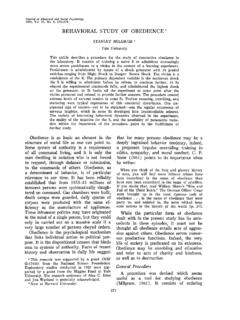Transcription of Research Methods in
1 Research Methods inEducationThis rewritten and updated sixth edition of the long-running bestsellerResearch Methods in Educationcovers the whole range of Methods currently employed by educational Research at all stages. It has fivemain parts: the context of educational Research , planning educational Research , styles of educationalresearch, strategies for data collection and researching and data analysis. The book contains referencesto a comprehensive dedicated web site of accompanying materials. It continues to be the standard textfor students and lecturers undertaking, understanding and using educational sixth edition comprises new material including:Ocomplexity theory, ethics, sampling, sensitive educational Research , researching powerful people,Internet-based Research , interviewing and surveysOexpanded coverage of, and practical guidance in, experimental Research , questionnaire design andadministrationOan entirely new part, containing five new chapters covering qualitative and quantitative data analysisincluding content analysis, grounded theory, statistics and how to use them, effect size, and reportingdata, all with practical examplesOdetailed cross-referencing to a major educational resource web site designed specifically to runalongside this Methods in Education,sixthedition.
2 Isessentialreadingforboththeprofessional researcherandanyone involved in educational Cohenis Emeritus Professor of Education at Loughborough University, Manionwas former Principal Lecturer in Music at Didsbury School of Education, ManchesterMetropolitan University, Morrisonis Professor of Education at the Inter-University Institute of Macau and formerly SeniorLecturer in Education at the University of Durham, Methods inEducationSixth editionLouis Cohen, Lawrence Manionand Keith MorrisonFirst published 2007 by Routledge2 ParkSquare,MiltonPark,Abingdon,OxonOX144 RNSimultaneously published in the USA and Canadaby Routledge270 Madison Avenue, New York, NY 10016 Routledge is an imprint of the Taylor & Francis Group, an informa business 2007 Louis Cohen, Lawrence Manion and Keith or utilised in any form or by any electronic,mechanical,orothermeans,nowkn ownorhereafterinvented, including photocopying and recording, or in anyinformation storage or retrieval system, without permission inwriting from the Library Cataloguing in Publication DataAcataloguerecordforthisbookisavailab lefromtheBritishLibraryLibrary of Congress Cataloging-in-Publication DataAcatalogrecordforthisbookhasbeenrequ estedISBN 10: 0 415 37410 3 (hbk)ISBN 10: 0 415 36878 2 (pbk)ISBN 10: 0 203 02905 4 (ebk)ISBN 13: 978 0 415 37410 1 (hbk)ISBN 13: 978 0 415 36878 0 (pbk)ISBN 13: 978 0 203 02905 3 (ebk)This edition published in the Taylor & Francis e-Library,2007.
3 To purchase your own copy of this or any of Taylor & Francis or Routledge scollection of thousands of eBooks please go to ISBN 0-203-02905-4 Mastere-bookISBNFor Lawrence Manion, a wise counsellor and a good friendContentsList of boxesxiiiAcknowledgementsxviiIntroductio n1 Part 1 The context of educational research1 The nature of inquiry Setting thefieldIntroduction5 The search for truth5 Two conceptions of social reality7 Positivism9 The assumptions and nature ofscience11 The tools of science14 The scientific method15 Criticisms of positivism and the scientificmethod17 Alternatives to positivistic social science:naturalistic approaches19 Aquestionofterminology:thenormativeand interpretive paradigms21 Phenomenology, ethnomethodology andsymbolic interactionism22 Criticisms of the naturalistic and interpretiveapproaches25 Critical theory and critical educationalresearch26 Criticisms of approaches from criticaltheory29 Critical theory and curriculumresearch30 Asummaryofthethreeparadigms32 The emerging paradigm of complexitytheory33 Feminist research34 Research and evaluation41 Research .
4 Politics and policy-making46 Methods and methodology47 Part 2 Planning educational research2 TheethicsofeducationalandsocialresearchI ntroduction51 Informed consent52 Access and acceptance55 The field of ethics58 Sources of tension58 Voices of experience61 Ethical dilemmas62 Ethics and Research Methods ineducation69 Ethics and evaluative research70 Research and regulation: ethical codes andreview71 Sponsored research74 Responsibilities to the researchcommunity75 Conclusion753 PlanningeducationalresearchIntroduction7 8 Aframeworkforplanningresearch78 Aplanningmatrixforresearch87viiiCONTENTS M anaging the planning of research93 Aworkedexample95 Conclusion984 SamplingIntroduction100 The sample size101 Sampling error106 The representativeness of the sample 108 The access to the sample109 The sampling strategy to be used110 Probability samples110 Non-probability samples113 Planning a sampling strategy117 Conclusion1175 SensitiveeducationalresearchWhat is sensitive Research ?
5 119 Sampling and access121 Ethical issues in sensitive research124 Researching powerful people127 Asking questions130 Conclusion1316 ValidityandreliabilityDefining validity133 Triangulation141 Ensuring validity144 Reliability in quantitative research146 Reliability in qualitative research148 Validity and reliability in interviews150 Validity and reliability inexperiments155 Validity and reliability inquestionnaires157 Validity and reliability inobservations158 Validity and reliability in tests159 Validity and reliability in lifehistories164 Part 3 Styles of educational research7 NaturalisticandethnographicresearchEleme nts of naturalistic inquiry167 Planning naturalistic research171 Critical ethnography186 Some problems with ethnographic andnaturalistic approaches1888 HistoricalanddocumentaryresearchIntroduc tion191 Choice of subject192 Data collection193 Evaluation194 Writing the Research report195 The use of quantitative methods197 Life histories198 Documentary research2019 Surveys,longitudinal,cross-sectionaland trend studiesIntroduction205 Some preliminary considerations207 Planning a survey208 Survey sampling211 Longitudinal, cross-sectional and trendstudies211 Strengths and weaknesses of longitudinal,cohort and cross-sectional studies214 Postal.
6 Interview and telephonesurveys218 Event history analysis22410 Internet-based Research and computerusageIntroduction226 Internet-based surveys226 Internet-based experiments239 Internet-based interviews241 CONTENTS ixSearching for Research materials on theInternet242 Evaluating web sites244 Computer simulations245 Geographical Information Systems25111 Case studiesWhat is a case study?253 Examples of kinds of case study258 Why participant observation?260 Recording observations260 Planning a case study261 Writing up a case study262 Conclusion26312Ex post factoresearchIntroduction264Co-relationa l and criterion groupsdesigns265 Characteristics ofex post factoresearch266 Occasions when appropriate268 Advantages and disadvantages ofex post factoresearch268 Designing anex post factoinvestigation269 Procedures inex post factoresearch27013 Experiments, quasi-experiments,single-case Research and meta-analysisIntroduction272 Designs in educationalexperimentation274 True experimental designs275 Aquasi-experimentaldesign:thenon-equival ent control group design282 Single-case Research .
7 ABAB design284 Procedures in conducting experimentalresearch285 Examples from educational research287 Evidence-based educational Research andmeta-analysis28914 Action researchIntroduction297 Defining action research297 Principles and characteristics of actionresearch299 Action Research as critical praxis302 Procedures for action research304 Reflexivity in action research310 Some practical and theoreticalmatters311 Conclusion312 Part 4 Strategies for data collection andresearching15 QuestionnairesIntroduction317 Ethical issues317 Approaching the planning of aquestionnaire318 Types of questionnaire items321 Asking sensitive questions333 Avoiding pitfalls in question writing334 Sequencing the questions336 Questionnaires containing few verbalitems337 The layout of the questionnaire338 Covering letters or sheets and follow-upletters339 Piloting the questionnaire341 Practical considerations in questionnairedesign342 Administering questionnaires344 Processing questionnaire data34616 InterviewsIntroduction349 Conceptions of the interview349 Purposes of the interview351 Types of interview352xCONTENTSP lanning interview-based researchprocedures356 Group interviewing373 Interviewing children374 Focus groups376 The non-directive interview and thefocused interview377 Telephone interviewing379 Ethical issues in interviewing38217 AccountsIntroduction384 The ethogenic approach384 Characteristics of accounts andepisodes384 Procedures in eliciting, analysing andauthenticating accounts.
8 An example 385 Network analyses of qualitative data388 What makes a good network?388 Discourse analysis389 Analysing social episodes391 Account gathering in educationalresearch: an example391 Problems in gathering and analysingaccounts392 Strengths of the ethogenic approach393 Anoteonstories39418 ObservationIntroduction396 Structured observation398 Critical incidents404 Naturalistic and participantobservation404 Natural and artificial settings forobservation408 Ethical considerations408 Some cautionary comments410 Conclusion41219 TestsIntroduction414 What are we testing?414 parametric and non- parametric tests414 Norm-referenced, criterion-referencedand domain-referenced tests415 Commercially produced tests andresearcher-produced tests416 Constructing a test418 Devising a pretest and post-test432 Reliability and validity of tests432 Ethical issues in preparing for tests432 Computerized adaptive testing43320 Personal constructsIntroduction435 Characteristics of the method435 Elicited versus provided constructs 436 Allotting elements to constructs437 Laddering and pyramid constructions 439 Grid administration and analysis439 Procedures in grid administration439 Procedures in grid analysis439 Strengths of repertory grid technique 442 Difficulties in the use of repertory gridtechnique442 Some examples of the use of repertorygrid in educational research443 Grid technique
9 And audio/video lessonrecording445 Focused grids, non-verbal grids, exchangegrids and sociogrids44621 Role-playingIntroduction448 Role-playing versus deception: theargument450 Role-playing versus deception: theevidence451 Role-playing in educational settings452 The uses of role-playing452 Strengths and weaknesses of role-playingand other simulation exercises455 Role-playing in an educational setting:an example455 Evaluating role-playing and othersimulation exercises456 CONTENTS xiPart 5 Data analysis22 Approaches to qualitative data analysisIntroduction461 Tabulating data463 Five ways of organizing and presentingdata analysis467 Systematic approaches to dataanalysis469 Methodological tools for analysingqualitative data47323 Content analysis and grounded theoryIntroduction475 What is content analysis?
10 475 How does content analysis work?476 Aworkedexampleofcontentanalysis483 Computer usage in content analysis487 Reliability in content analysis490 Grounded theory491 Interpretation in qualitative dataanalysis: multilayered texts49524 Quantitative data analysisIntroduction501 Scales of data502 parametric and non- parametric data503 Descriptive and inferential statistics503 One-tailed and two-tailed tests504 Dependent and independentvariables504 Reliability506 Exploratory data analysis: frequencies,percentages and cross-tabulations506 Statisti





